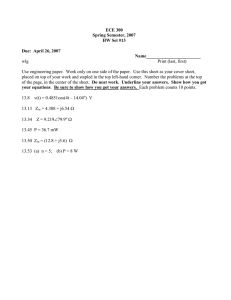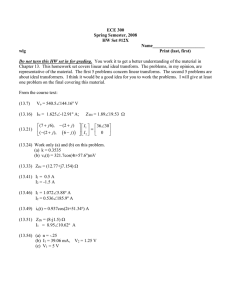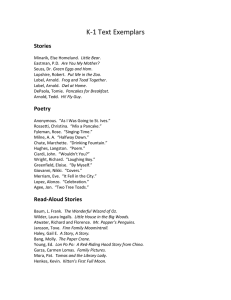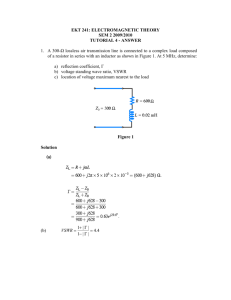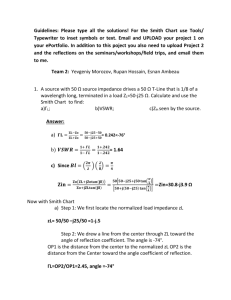Tutorial 8 Nov. 17
advertisement
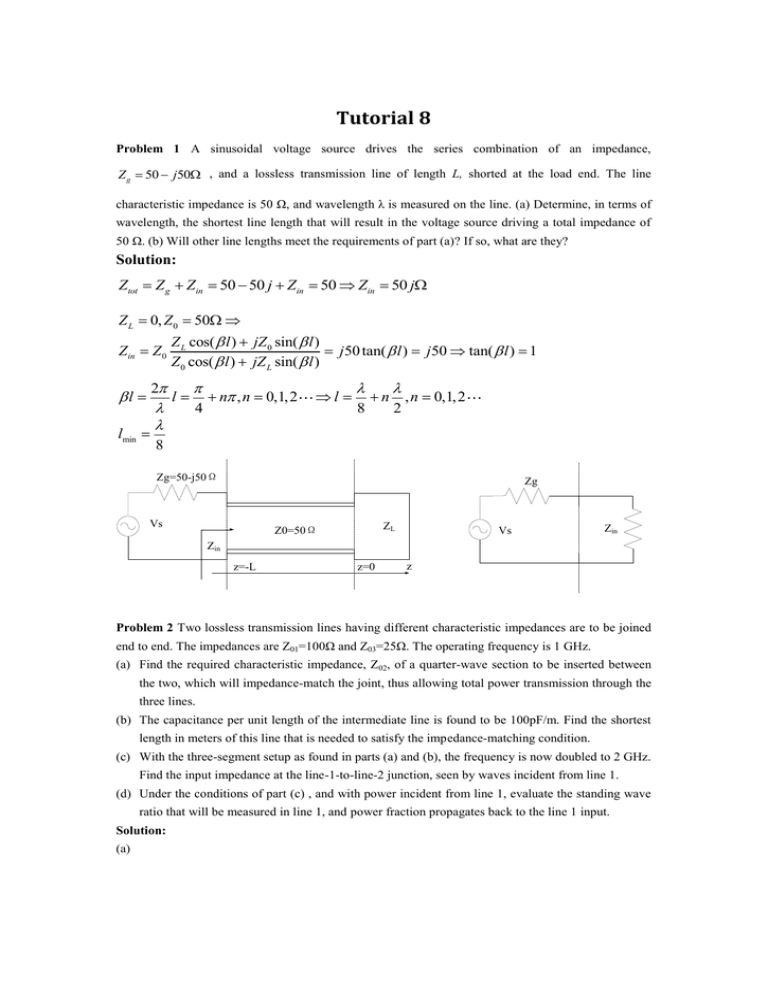
Tutorial 8 Problem 1 A sinusoidal voltage source drives the series combination of an impedance, Z g 50 j50 , and a lossless transmission line of length L, shorted at the load end. The line characteristic impedance is 50 Ω, and wavelength λ is measured on the line. (a) Determine, in terms of wavelength, the shortest line length that will result in the voltage source driving a total impedance of 50 Ω. (b) Will other line lengths meet the requirements of part (a)? If so, what are they? Solution: Ztot Z g Zin 50 50 j Zin 50 Zin 50 j Z L 0, Z 0 50 Zin Z 0 2 l lmin Z L cos( l ) jZ 0 sin( l ) j50 tan( l ) j50 tan( l ) 1 Z 0 cos( l ) jZ L sin( l ) l 4 n , n 0,1,2 l n , n 0,1,2 8 2 8 Zg=50-j50Ω Zg Vs ZL Z0=50Ω Vs Zin Zin z=-L z=0 z Problem 2 Two lossless transmission lines having different characteristic impedances are to be joined end to end. The impedances are Z01=100Ω and Z03=25Ω. The operating frequency is 1 GHz. (a) Find the required characteristic impedance, Z02, of a quarter-wave section to be inserted between the two, which will impedance-match the joint, thus allowing total power transmission through the three lines. (b) The capacitance per unit length of the intermediate line is found to be 100pF/m. Find the shortest length in meters of this line that is needed to satisfy the impedance-matching condition. (c) With the three-segment setup as found in parts (a) and (b), the frequency is now doubled to 2 GHz. Find the input impedance at the line-1-to-line-2 junction, seen by waves incident from line 1. (d) Under the conditions of part (c) , and with power incident from line 1, evaluate the standing wave ratio that will be measured in line 1, and power fraction propagates back to the line 1 input. Solution: (a) Z01=100Ω Z03=25Ω Z01=100Ω Zin=Z03=25Ω Zin Z01=100Ω Z02 Z03=25Ω 25Ω Z01=100Ω Z02 Z01=100Ω Zin Zin Zin Total power transmission means the reflection at line-1-to-line-2 junction is 0, which is or Zin=Z01. As the length of line 2 is quarter-wave, so Zin Z 02 (b) Z 03 cos( l ) jZ 02 sin( l ) Z 022 Z 01 Z 02 Z 01Z 03 50 Z 02 cos( l ) jZ 03 sin( l ) Z 03 LC , 2 1 0.2m LC f LC 25cos( l ) j50sin( l ) m 100 cos( l ) 0 l , m 0,1,2 50cos( l ) j 25sin( l ) 4 2 lmin 0.05m 4 f 2GHz l LC l 2 f LCl Zin 50 (d) 2 Zin Z01 To make (c) 2 4 2 L 50 L Z 022 C 0.25μH/m C Z 02 50 l 25cos( l ) j50sin( l ) 25 50cos( l ) j 25sin( l ) Z L Z 0 Zin Z 01 1 | | 0.6 s 4 Z L Z 0 Zin Z 01 1 | | Preflected Pincident | |2 0.36 12 0 Problem 3: Slotted line measurements yield a VSWR of 5, a 15-cm spacing between successive voltage maxima, and the first maximum at a distance of 7.5cm in front of the load. Determine the load impedance, assuming a 50-Ω impedance for the slotted line. Solution: Assume | | e j Vs ( z ) (V0e j z V0e j z ) V0e j z (1 | | e j (2 z ) ) m , m 0,1,2 4 2 m , m 0,1,2 4 4 2 Vmax 1 | |, 2 z 2m zmax Vmin |1 | ||, 2 z 2m zmin s Vmax 1 | | s 1 2 | | Vmin 1 | | s 1 3 zmax zm,max zm1,max z1,max 2 =15cm =30cm 7.5cm 4 | | e j 2 3 Z L Z0 Z L 10 Z L Z0
